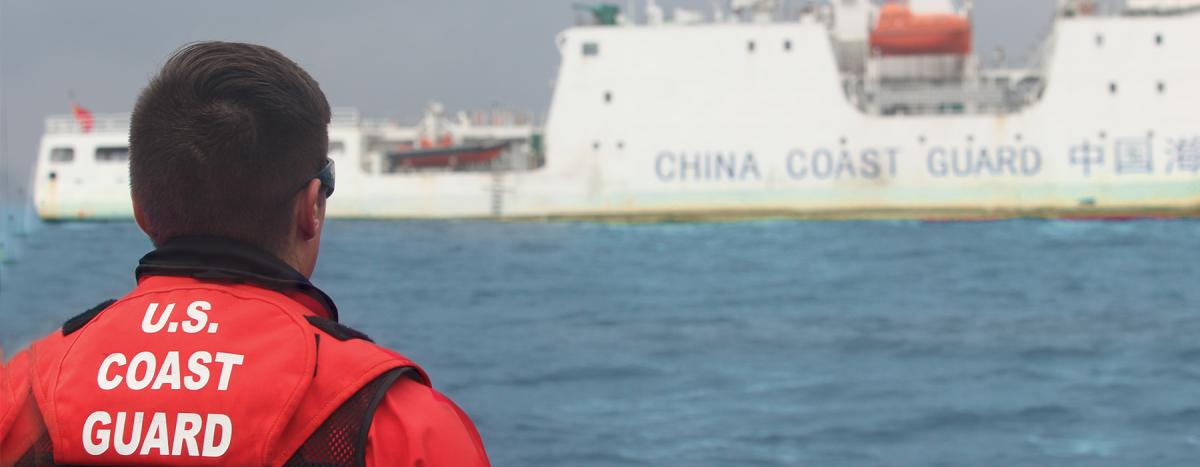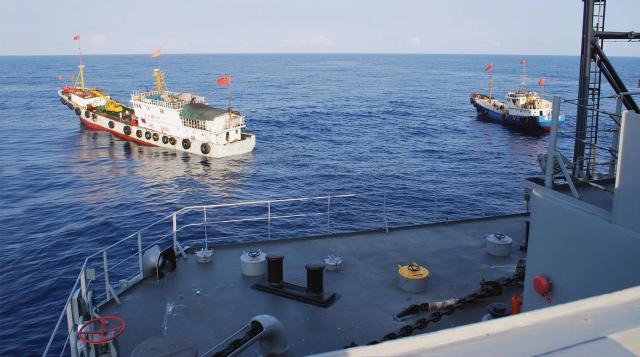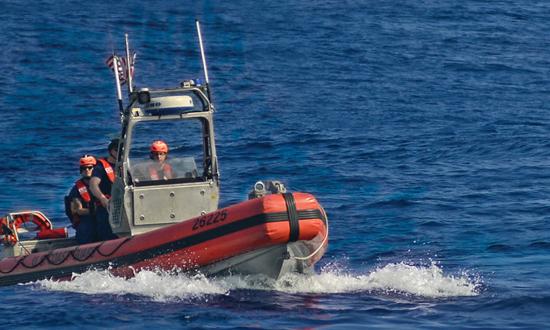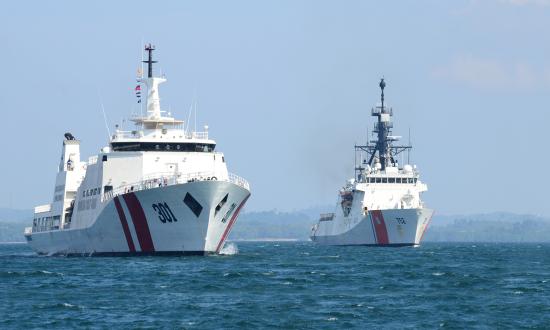Over the course of history, confusion, miscommunication, and accidents have led to significant armed conflicts. Today, the situation in the Indo-Pacific seems ripe for such an inadvertent and potentially catastrophic military escalation—particularly in interactions between the China Coast Guard (CCG) and the U.S. Coast Guard. Efforts to clarify operating procedures to guide interactions between the services have stalled, leaving these two capable forces operating in close proximity in a murky operational theater. This could be a recipe for disaster.
Failed Efforts To Establish Guardrails
Chinese and U.S. officials have acknowledged the risks posed by the evolving CCG and increased U.S. Coast Guard presence in the region. In 2016, officials from the two services met to negotiate a “rules of behavior” agreement (ROB) to govern interactions and decrease risk during unplanned encounters at sea. These agreements are routine, largely reflecting the Convention on the International Regulations for Preventing Collisions at Sea.
The U.S. Navy, for example, operates under an ROB signed in 2014 between the Department of Defense (DoD) and the Chinese Ministry of Defense.1 The agreement outlines how DoD’s air and maritime forces will interact with their Chinese counterparts. Unfortunately, the Department of Homeland Security (which houses the U.S. Coast Guard) is not party to that agreement, and coast guards were not explicitly addressed in the text.
During the 2016 meeting between Chinese and U.S. Coast Guard officials, the Chinese refused to sign onto a coast guard–specific ROB. They worried it might inhibit their ability to engage in law enforcement action. This left some U.S. officials with the unsettling impression that China was asserting unprecedented authority to take law enforcement action against U.S. Coast Guard vessels.2
The United States could attempt to rely on the 2014 agreement between DoD and the Chinese Ministry of Defense, which applies to all U.S. “warships” (U.S. Coast Guard cutters are warships under international law). However, the actions of both parties make clear that neither believes the U.S. Coast Guard is covered by the agreement. Furthermore, it is not clear that China under- stands, or wants to understand, the legal status of U.S. Coast Guard cutters.
Further undermining any argument that the 2014 agreement applies to the Coast Guard is the fact that the agreement is specifically between defense agencies, creating ambiguity about the status of coast guard forces not operating under the tactical or operational control of the defense apparatus in each nation. U.S. Coast Guard cutters operate under the control of both Coast Guard operational commands and DoD commands, often switching between the two, depending on the mission. This switch- ing of tactical control is how cutters accomplish their law enforcement missions even when on a defense deployment, respecting the Navy’s status under posse comitatus.
Chinese Coast Guard Law
Much has changed since 2016, and those changes have made the Indo-Pacific operational theater only more perilous. Two of the most consequential developments are China’s shipbuilding boom (military and commercial) and its recently promulgated coast guard law, which empowers the CCG as both a military and law enforcement entity.3
Particularly concerning to the international community is the new law’s use-of-force provision, which authorizes the CCG to “take all necessary measures, including the use of weapons” to stop vessels from infringing on China’s “sovereign” waters. On its own, this provision is not especially threatening. It is similar to the U.S. Coast Guard’s Title 14 authorities.
The U.S. Coast Guard frequently uses force in law enforcement encounters at sea, but most often in the context of counternarcotics operations against stateless vessels. It exercises very limited use-of-force authority against foreign-flagged vessels, and usually only with the flag state’s permission under a prenegotiated agreement or in close coordination with other agencies. This care- fully controlled exercise of authority is designed to pre- vent the use of force against a sovereign vessel of another state, which could be construed as a hostile act.
CCG forces have not exercised the same restraint. Relying on its overwhelming size and capabilities, it has instead engaged in increasingly aggressive behavior with respect to smaller regional coast guards, including “shouldering” or ramming vessels to force them to divert from their course. This tactic is available to U.S. Coast Guard commanders, but it is very rarely used because of how dangerous it can be for both vessels involved. For the Chinese, though, this has become a favored law enforcement tactic. In fact, the newest class of CCG vessels seem to be designed specifically for that purpose.4
Even before the 2021 law, the CCG had been used by Beijing to intimidate and threaten other claimant states in the South and East China Seas. Adding to the problem, the CCG lacks a robust command-and-control mechanism to oversee its on-scene commanders’ exercise of power; is only just building the extensive training needed for coast guard officers; and has no independent judiciary that can check the exercise of these authorities.
These factors, combined with an increased U.S. Coast Guard presence in the region, have some concerned that Chinese maritime forces are apt to do what some senior Chinese military officials have explicitly called for: shoulder or ram U.S. vessels “infringing” on their self-proclaimed sovereign waters in the East and South China Seas.5 Without established rules of behavior, this could be an invitation for military escalation.
Testing The Waters
Over the past 15 years, it has become clear that Chinese forces are not afraid to confront sovereign vessels of the United States. One of the most provocative encounters was the harassment of the USNS Impeccable (T-AGOS-23), an unarmed Military Sealift Command ship, by five Chinese vessels in 2009.6 In 2016, Chinese forces seized an “ocean glider” drone from the USNS Bowditch (T-AGS-62), an oceanographic survey ship, in the South China Sea.7 Neither incident resulted in significant costs to China and were answered with diplomatic correspondence from the United States. The next encounter could entail more direct, aggressive engagement.
the USNS Impeccable (T-AGOS-23) by Chinese trawlers demonstrated. Clear procedures for how the CCG and maritime militia will behave in encounters with the U.S. Coast Guard could prevent escalation. Credit: U.S. Navy
Ramming a U.S. Navy warship transiting contested waters might seem too provocative, but targeting a smaller white hull could be an attractive next step in China’s efforts to defend its unlawful maritime claims. This is particularly true if the CCG could claim it was engaged in legitimate law enforcement action against a vessel illegally entering Chinese sovereign waters rather than an armed attack on a sovereign warship. That ambiguity might be attractive to both nations, providing space and time to maneuver diplomatically. However, it also could be seen as failing to defend the sovereign immune status of U.S. Coast Guard cutters, thereby undermining the international rules-based order the United States seeks to protect.
A Proposed Way Ahead
One way to establish a guardrail in the Indo-Pacific theater is to engage China directly to clarify procedures for how the CCG and maritime militia will behave in encounters with the U.S. Coast Guard.
The United States should make clear that the U.S. Coast Guard is immune from CCG law enforcement actions and that any use of force against a Coast Guard vessel would be considered an attack against a U.S. war- ship, which could trigger the right to use force in self-defense. Preferably, this should be captured in an agreement similar to or added as an addendum to the current ROB between DoD and China’s Ministry of Defense.
As Chinese maritime forces and their domestic authorities expand, so has demand for U.S. Coast Guard forces in the Indo-Pacific. There is no region more in need of a bridge between diplomacy and lethality in the maritime domain than the South and East China Seas—and no agency better suited to fill this role than the U.S. Coast Guard. It provides unique law enforcement authorities blended with defense capabilities and a humanitarian focus. It can protect critical fish stocks and prevent illicit smuggling, while also providing the defense capabilities of a warship, without the threatening image of an Aegis destroyer. In other words, the Coast Guard is often the right tool for the complex geopolitical dynamics of the Indo-Pacific.
But given the growing tensions in the region, continuing to send U.S. Coast Guard crews into disputed waters where encounters with the Chinese fleet are becoming increasingly common risks embroiling the United States in a conflict with China. Should a U.S. Coast Guard cutter use force to defend itself, the situation might quickly escalate.
Setting expectations now and affirming the legal status of U.S. Coast Guard cutters would hinder China’s ability to take advantage of legal ambiguities to extend its reach and influence in the region. It also would ensure that any extended or resultant conflict with China was the result of choice, strategy, and necessity, and not the product of a catastrophic misunderstanding.
- Department of Defense, “Memorandum of Understanding between the Depart- ment of Defense of the United States of America and the Ministry of National Defense of the People’s Republic of China Regarding the Rules of Behavior for Safety of Air and Maritime Encounters.”
- Bostonbruen, “It Is Time to Police the Chinese Coast Guard,” 9 April 2021, medium.com/@bstnbruen_17929/it-is-time-to-police-the-chinese-coast-guard- 58d725b1ab80.
- Shigeki Sakamoto, “China’s New Coast Guard Law and Implications for Mari- time Security in the East and South China Seas,” Lawfare, 16 February 2021.
- David Axe “Huge New Chinese Ships Are Made for Ramming,” Forbes, 15 January 2021.
- Ryan Pickrell, “Senior Chinese Military Officer Calls for Attacks on U.S. Ships in the South China Sea,” Business Insider, 10 December 2018.
- Michael Green, Kathleen Hicks, Zack Cooper, John Schaus, and Jake Douglas, “Harassment of the USNS Impeccable,” Asia Maritime Transparency Initiative, CSIS.org, 9 May 2017.
- “China ‘Seizes U.S. Vessel’ in S. China Sea,” BBC.com, 16 December 2016.







